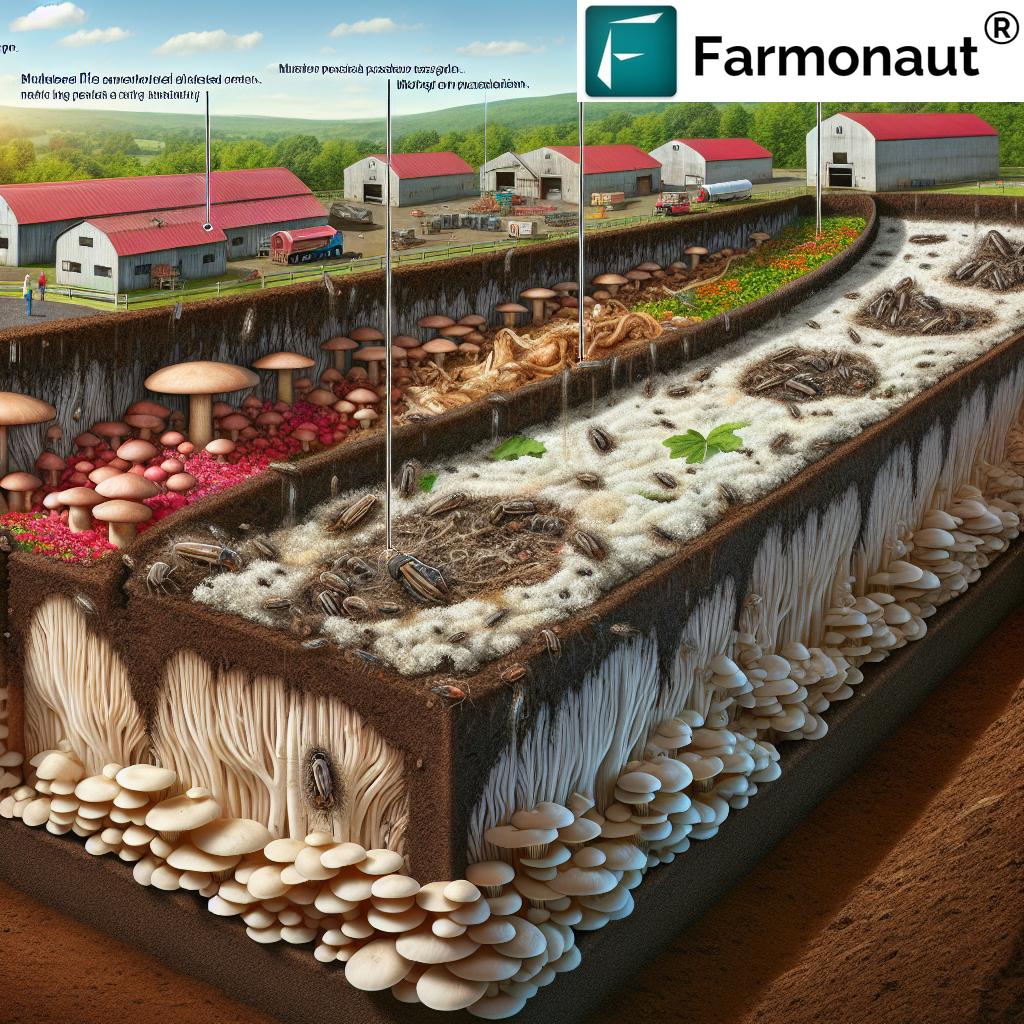Anaerobic Conditions in Soil: Impact on California Drought 2025
“Anaerobic soil conditions can reduce crop yields by up to 40% during severe droughts like California’s projected 2025 event.”
Introduction: Anaerobic Soil Conditions and Their Implications Amid California’s 2025 Drought
California confronts severe drought conditions in 2025, exposing agriculture, forestry, and the broader ecosystem to unprecedented environmental stressors. As droughts become increasingly prolonged and intense, soil health and water management practices emerge as core concerns for food security and ecological resilience. Of particular significance is the prevalence of anaerobic conditions in soil—zones where oxygen is drastically depleted and fundamental soil processes are fundamentally altered.
Anaerobic soil is not limited to flooded or saturated environments; amid drought, this phenomenon often presents in less obvious, localized pockets such as compacted soil layers, poorly drained irrigation zones, and subsurface layers with poor diffusion. The balance of water, air, and organic matter in soils during California drought conditions 2025 is critical in determining whether aerobic or anaerobic processes—each carrying profound implications—will dominate.
This comprehensive guide examines how anaerobic conditions in soil impact soil structure, root health, crop productivity, soil biology, nutrient cycling, and management strategies for a sustainable future. Our aim is to empower decision-makers—farmers, land managers, and policy-makers—with a sound understanding of the soil’s hidden dynamics under extreme climatic stress.
To further support sustainable practices and environmental health, modern remote-sensing solutions and data-driven platforms like Farmonaut have become pivotal. By integrating satellite imagery and precision tools into their large-scale farm management platform, Farmonaut helps agricultural businesses monitor soil, crop health, and moisture stress at scale, making resilience possible even under one of history’s most severe California drought conditions 2025.
Understanding Anaerobic Conditions in Soil
What Are Anaerobic Conditions in Soil?
Anaerobic conditions in soil occur when the oxygen present in soil pores is depleted or entirely absent, creating environments where only specialized microorganisms can thrive. This typically results from saturated or poorly-aerated soils where air cannot sufficiently penetrate the soil profile. Under anaerobic conditions, essential soil processes fundamentally change:
- Microbial Activity: Aerobic microorganisms die or go dormant, and anaerobic microbes, such as denitrifiers and methanogens, become dominant.
- Nutrient Cycling: Processes like nitrification halt, while alternative electron acceptors (e.g., nitrate, sulfate, iron) are used by bacteria for respiration.
- Gas Production: Gases such as methane, nitrous oxide, and hydrogen sulfide are often released, which can have ecological and atmospheric implications.
- Organic Matter Decomposition: Anaerobic breakdown of organic matter is much slower and less efficient.
Typical vs. Anaerobic Soil: The Role of Aeration and Water Balance
Healthy soils are characterized by a delicate balance between water and air in soil pores. Under typical conditions, oxygen can sufficiently penetrate the soil, supporting a thriving community of aerobic microorganisms vital for nutrient cycling, organic matter decomposition, and overall soil health. However, anaerobic soil develops when this balance is disrupted:
- Water Saturation: Saturated or waterlogged soils, whether due to excessive irrigation or rainfall, force out air and displace oxygen.
- Compaction: Heavy machinery or livestock may compact soil, reducing porosity and slowing diffusion of gases.
Anaerobic soil is characterized by the lack of oxygen, fundamentally altering both soil chemistry and biology.
Biological and Chemical Shifts Under Anaerobic Stress
- Biology: The growth of anaerobic microbes is promoted—organisms that use alternative electron acceptors (such as nitrate, sulfate, or iron), and whose metabolic byproducts can be toxic to plants (e.g., hydrogen sulfide).
- Chemistry: Decreased nitrate availability due to denitrification; increase in reduced compounds like nitrous oxide, methane.
- Ecosystem Impacts: Disruption of nutrient availability, inhibiting plant vigor and productivity.
Anaerobic Soil Is Not Just About Floods: The California Drought 2025 Scenario
Although anaerobic soil is often associated with flooded or waterlogged land, drought conditions in California 2025 present a nuanced challenge. Amid prolonged dry spells, certain micro-sites—such as deep layers, compacted zones, or localized patches exposed to over-irrigation—can develop anaerobic pockets. These are induced when irrigation is poorly managed or through abrupt water application followed by rapid drying, particularly in uneven fields or soils with poor drainage.
Key Takeaways: When Does Anaerobic Soil Occur?
- In compacted soils where air cannot diffuse effectively.
- Following over-irrigation during drought, especially on uneven fields.
- In deeper soil layers that retain water and exclude oxygen.
- In low-lying landscape areas (e.g., near wetlands or streams), where soil moisture persists longer even amid drought.
It is these anaerobic “pockets” that may affect root health, nutrient availability, and crop susceptibility to pathogens and environmental stress.
How California Drought Conditions 2025 Influence Soil Aeration
California drought conditions 2025 are unique in both their severe intensity and duration. The landscape, soil structure, and human interventions—especially irrigation—all contribute to the occurrence of anaerobic zones in an otherwise dry context.
Drought’s Dual Threat: How Scarcity and Excess Both Trigger Anaerobic Soil
- Water Scarcity: Drying soils lead to aerobic stress—microbial cycling slows, and plants risk desiccation, particularly for shallow-rooted species.
- Overcompensation via Irrigation: In a bid to save crops, over-irrigation—without considering soil drainage or structure—can lead to saturated pockets. Here, oxygen is displaced, causing localized anaerobic environments in deep or compacted zones.
Factors Compounding the Risk of Anaerobic Soil in Drought:
- Compaction: Heavy equipment, even during dry periods, compacts soil, blocking air channels and slowing oxygen diffusion.
- Soil Texture: Clay-rich soils retain more moisture and, when wet, are prone to becoming anaerobic.
- Organic Matter: Loss of surface plant cover or organic inputs reduces soil structure and infiltration, making it more vulnerable to compaction and poor gas exchange.
- Microbial Activity: With drought and subsequent overwatering, aerobic microbial populations plummet; anaerobic microbes flourish, producing compounds like methane, nitrous oxide, and hydrogen sulfide.
Impact on Soil Health and Crop Productivity Under Anaerobic Soil
“In 2025, over 1.2 million acres in California may face anaerobic stress, threatening long-term soil sustainability.”
Anaerobic Conditions in Soil: A Major Threat to California Agriculture
The agricultural sector of California is heavily dependent on consistent irrigation and a stable soil environment for sustainable productivity. Anaerobic conditions in soil impact crop health, root function, and ultimately yield.
Effects on Root Health and Plant Growth
- Root Hypoxia: Roots deprived of oxygen switch to less efficient respiration, leading to energy deficits in crops like almonds and grapes.
- Susceptibility: Anaerobic zones increase risk of root diseases (e.g., Phytophthora), reducing vigor and long-term resilience.
- Nutrient Uptake: Restricted movement of nutrients, particularly nitrate, as denitrification is accelerated, causing lower fertilizer use efficiency.
- Yield Decline: Yield reductions of up to 30–50% have been recorded, particularly when exposure to anaerobic pockets coincides with critical plant growth stages.
In the 2025 drought scenario, if irrigation management is poor or compaction is not addressed, these issues directly impact the economic sustainability of California’s agricultural enterprises.
Crop-Specific Sensitivity and Risks
- Annual Row Crops: Crops like tomatoes and lettuce are highly sensitive to anaerobic soil—even short-term hypoxia can disrupt growth cycles.
- Perennial Orchards and Vineyards: More prone to lasting impacts. Compacted soils restrict oxygen in deeper layers, damaging roots critical for nutrient uptake and anchoring.
Soil structure—from porosity to organic content—and species-specific rooting depth define which fields suffer the greatest consequences.
Greenhouse Gas Emissions: Environmental Impact Beyond the Field
Anaerobic soil conditions often lead to increased production of potent greenhouse gases (GHGs) like nitrous oxide and methane. These contribute not only to local air quality degradation but also to global climate change—a significant concern in one of America’s leading agricultural states.
Key Indicators of Anaerobic Soil Stress in Agriculture
- Off-odors (due to hydrogen sulfide)
- Visible stunting or yellowing in plant canopies
- Patchy or uneven field growth, potentially indicating localized anaerobic pockets
- Reduced effectiveness of nitrogen-based fertilization due to denitrification
Protect Your Farm’s Financial Stability: If your field is at risk due to drought or anaerobic soil stress, satellite-based crop loan and insurance solutions from Farmonaut can offer critical verification tools and reduce your exposure to loss.
Precision Solutions: How Modern Tools Help Address Soil Stress
Remote-sensing technology and satellite-based systems have become invaluable in monitoring moisture, organic matter loss, and the prevalence of anaerobic zones—allowing for precision interventions to prevent yield reduction.
Forestry, Ecosystem, and Soil Structure: Anaerobic Conditions Amid California’s Drying Forests
Anaerobic Pockets in California Forests: Not Just an Agricultural Problem
Drought not only endangers agricultural lands but also the vast forested expanses of California. While drying typically results in aerobic stress (lack of water/oxygen for roots), certain areas—like riparian or wetland-adjacent forests—may remain saturated enough to encourage anaerobic microenvironments. Here is where unique challenges emerge:
- Species Shifts: Tree and understory species less tolerant of hypoxia may die off, giving way to more resilient but less ecologically valuable plants.
- Root Health: Localized pockets of anaerobic stress increase susceptibility to pathogens, reduce nutrient uptake, and slow tree growth.
- Microbial Diversity: As aerobic bacteria decline, overall soil resilience and ecosystem function may be impaired.
Forest managers in California must carry out robust monitoring of oxygen status and potential anaerobic shifts, particularly in landscapes characterized by uneven drainage or historical wetland presence.
Beyond yield, soil health in forests under anaerobic stress also directly affects carbon storage, wildlife habitat, and long-term ecosystem stability.
For Forest Managers: Satellite-driven crop plantation and forest advisory services from Farmonaut help monitor forest soil health at scale, supporting intervention when localized anaerobic conditions arise amid droughts.
Environmental Consequences: From GHGs to Biodiversity Loss
- Increased GHG Emissions: Localized anaerobic soils contribute to methane and nitrous oxide release.
- Altered Soil Structure: Organic matter loss and compaction further reduce forest resilience to climatic shifts.
- Biodiversity Impacts: Both plant and microbial diversity decline, with cascading ecosystem effects.
Comparative Impact Table: Anaerobic vs. Aerobic Soil in California’s 2025 Drought
| Condition Type | Soil Health Indicators (Organic Matter Loss %) |
Nutrient Availability (Estimated Index) |
Crop Productivity (Yield Reduction %) |
Recommended Management Strategies |
|---|---|---|---|---|
| Anaerobic | 20–35% (High risk; accelerated decomposition, compaction loss) | Low (Reduced nitrogen; NO3– leaching, denitrification) | 30–50% (Major threat to yield, with variability by crop and site) |
|
| Aerobic | 5–12% (Moderate to low under drought) | Medium–High (Efficient cycling when moisture is adequate) | 10–15% (Reduced but more stable yields; drought still a factor) |
|
Sustainable Management Strategies for Anaerobic Soils During Drought
Mitigation Starts with Real-Time Monitoring and Precision
- Precision Irrigation: Drip irrigation and soil moisture sensor systems optimize water use to maintain adequate soil aeration and avoid creating saturated pockets.
- Soil Aeration Techniques: Deep ripping, subsoiling, or the use of cover crops with extensive root systems improve diffusion and porosity.
- Organic Amendments: Applying organic matter (compost, mulches) and biochar helps retain soil moisture without inducing saturation, supports microbial activity, and boosts the soil’s carbon footprint for long-term sustainability.
- Surface Drainage Improvement: Level and manage fields to avoid water pooling in low-lying or compacted areas.
For maximum benefit, combine these with continuous monitoring provided by modern satellite-enabled tools such as Farmonaut’s fleet and resource management system—allowing for real-time updates and rapid deployment of remedial equipment when needed.
Monitoring and Mapping Anaerobic Zones: Why It Matters
- Soil Redox Potential: Sensors can flag when oxygen content drops below critical levels in certain soil layers.
- Remote Sensing & Farmonaut: Satellite imagery can detect patches of soil with atypical water content or vegetation stress, enabling field-scale interventions. Farmonaut’s traceability solution is pivotal for auditing which fields need direct intervention and ensuring sustainable management across the supply chain.
- Differential Irrigation: Adjust rates based on soil mapping data from satellite and field sensors rather than uniform field-wide application.
Use Farmonaut Apps: Access cutting-edge field monitoring tools for real-time soil, crop, and moisture tracking from any web browser, Android, or iOS device.
Additional Sustainable Practices to Mitigate Anaerobic Conditions in Soil
- Crop Rotation: Rotating crops prevents uniform compaction and supports soil biodiversity, making fields less prone to persistent anaerobic zones.
- Reduced Tillage: Minimizes soil disturbance, maintaining structure and organic matter—essential for balanced water and air flow.
- Field Traffic Management: Limit heavy machinery movement, especially during moist periods, to reduce the risk of compaction-induced anaerobic zones.
The Role of Traceability, Sustainability, and Compliance
- Traceability is a cornerstone of sustainable agriculture. In drought-affected, high-risk landscapes, tracking soil conditions, input efficacy, and field operations ensures transparency, reduces fraud, and enables adaptive decision-making for long-term resilience.
- Compliance with environmental regulations is streamlined through integrated carbon and emission monitoring tools—crucial for aligning with state-wide climate goals in 2025 and beyond.
Farmonaut’s Role in Real-Time Soil Monitoring and Precision Agriculture
How We Empower Soil Health Management Amid California Drought Conditions 2025
At Farmonaut, we have made it our mission to democratize access to satellite-driven insights for soil health and sustainable field management. Through our advanced solutions, users gain essential data on (anaerobic soil risks, moisture distribution, crop stress, and more) even in the most challenging climatic scenarios—like the California drought conditions 2025.
- Satellite-Based Monitoring: Multispectral images delivered through our app or web platforms enable users to detect early signs of soil compaction and anaerobic pockets at a field, farm, or landscape scale.
- AI-Based Advisory: Our Jeevn AI system delivers real-time suggestions on irrigation scheduling, mitigating overwatering, and flagging likely anaerobic sites—helping users optimize farm inputs for yield, health, and sustainability.
- Resource Management: With our satellite APIs and developer tools, businesses can integrate continuous monitoring and adaptive management strategies into their own farm management systems, boosting sector-wide resilience.
- Blockchain-Enabled Traceability: Our technology improves the transparency of soil input usage, farm operations, and mitigation effectiveness, vital for both insurance verification and marketplace trust.
- Environmental Impact Tracking: Real-time carbon and emission monitoring enables compliance with evolving climate policies and grants access to incentives for climate-smart practices.
With Farmonaut, users ranging from individual farmers to large government agencies can rapidly adapt to changing soil, water, and climate dynamics, supporting the long-term viability of California’s food systems.
Conclusion: Building Resilience Against Anaerobic Soil Conditions in the 2025 Drought
The California drought conditions 2025 confronts us with severe challenges but also opportunities to rethink field management and environmental stewardship. While most attention to drought emphasizes water scarcity and aerobic stress, this crisis reveals the complex, hidden threat posed by anaerobic conditions in soil. From fields to forests, from roots to ecosystem canopy, understanding—and preventing—the development of oxygen-starved zones will be critical to securing future agricultural productivity and sustainable land use.
Effective responses hinge on precision monitoring, informed irrigation, integrated soil management, and robust traceability—the cornerstones of resilient, modern agriculture and forestry. Satellite-enabled tools like those offered by Farmonaut empower land managers across California to meet these challenges with actionable data and sustainable strategies.
As climate volatility intensifies, our best defense lies in anticipating risks, deploying the right tools, and nurturing a deeper understanding of our planet’s most fundamental resource—soil.
FAQ: Anaerobic Soil, California Drought, and Environmental Management
What are anaerobic conditions in soil?
Anaerobic soil conditions arise when soil oxygen content drops, preventing aerobic microorganisms from functioning normally. This is often due to compaction, poor drainage, or over-irrigation, even during drought.
How do anaerobic soil pockets form amid drought?
Despite widespread drying, areas of compaction, abrupt irrigation, or deep layers with poor drainage can create oxygen-deprived “pockets.” These are especially common with uneven irrigation practices during dry periods.
How do anaerobic conditions in soil impact crops?
Root hypoxia, nutrient loss (especially nitrogen), higher susceptibility to diseases like root rot, yield reductions (often up to 40%), and reduced fertilizer efficiency are the main impacts of anaerobic soils on agriculture.
How can satellite remote sensing help mitigate anaerobic soil issues?
Satellite imagery, such as services offered by Farmonaut, enables ongoing monitoring of soil moisture and crop health, allowing for early detection of anaerobic stress zones and data-driven interventions.
What sustainable management strategies can mitigate these risks?
Employ precision irrigation, avoid field compaction, facilitate drainage, enhance soil structure using organic matter and cover crops, and use real-time monitoring to intervene before damage is widespread.
Is traceability important for sustainable agriculture during drought?
Yes, traceability ensures all inputs and field interventions are recorded, enabling transparency, accountability, and improved access to crop insurance or compliance verification during environmental stress events.














